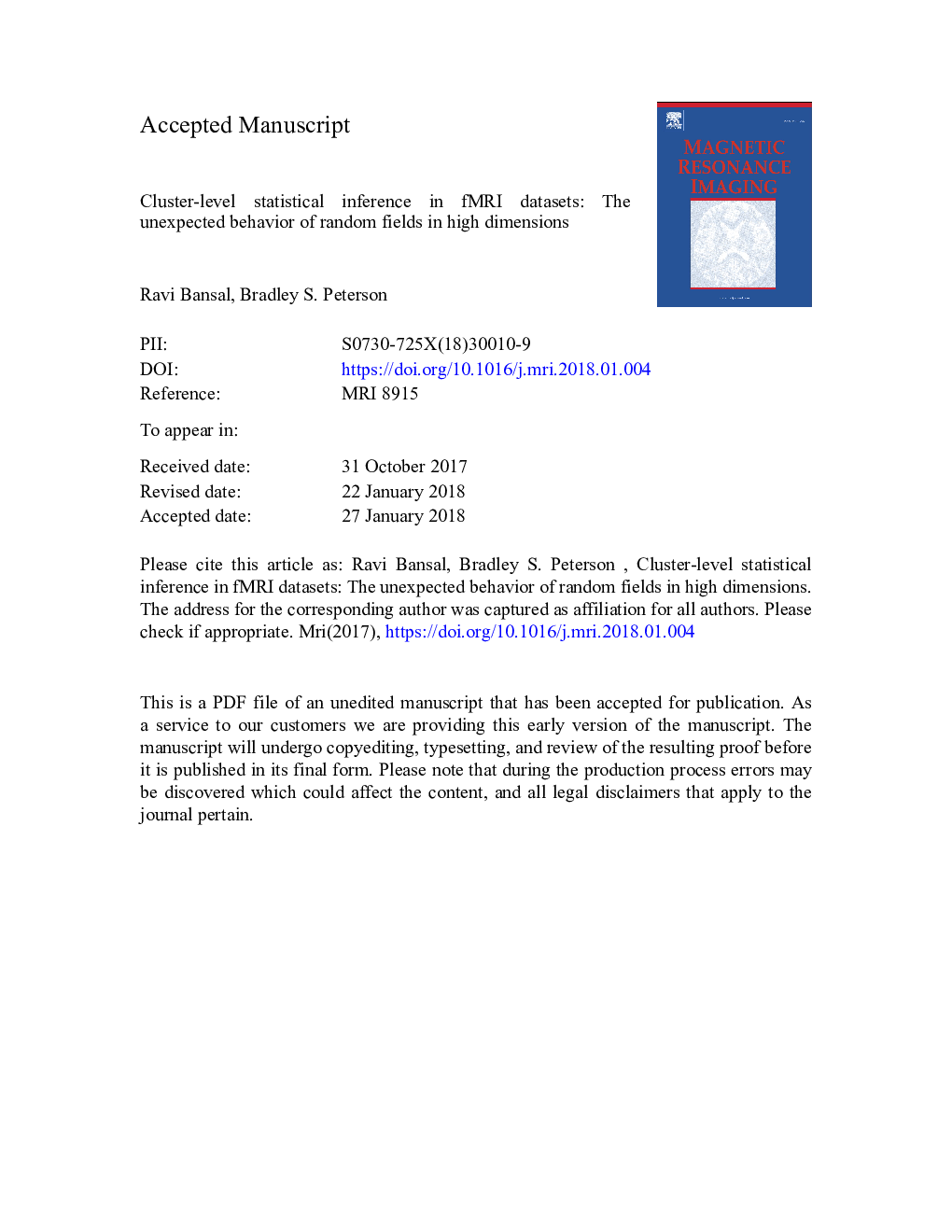| کد مقاله | کد نشریه | سال انتشار | مقاله انگلیسی | نسخه تمام متن |
|---|---|---|---|---|
| 8159867 | 1524994 | 2018 | 36 صفحه PDF | دانلود رایگان |
عنوان انگلیسی مقاله ISI
Cluster-level statistical inference in fMRI datasets: The unexpected behavior of random fields in high dimensions
دانلود مقاله + سفارش ترجمه
دانلود مقاله ISI انگلیسی
رایگان برای ایرانیان
موضوعات مرتبط
مهندسی و علوم پایه
فیزیک و نجوم
فیزیک ماده چگال
پیش نمایش صفحه اول مقاله

چکیده انگلیسی
To understand better why parametric methods may yield excessive false positives, we assessed their performance when applied both to simulated datasets of 1D, 2D, and 3D Gaussian Random Fields (GRFs) and to 710 real-world, resting-state fMRI datasets. We showed that both the simulated 2D and 3D GRFs and the real-world data contain a small percentage (<6%) of very large clusters (on average 60 times larger than the average cluster size), which were not present in 1D GRFs. These unexpectedly large clusters were deemed statistically significant using parametric methods, leading to empirical familywise error rates (FWERs) as high as 65%: the high empirical FWERs were not a consequence of parametric methods failing to model spatial smoothness accurately, but rather of these very large clusters that are inherently present in smooth, high-dimensional random fields. In fact, when discounting these very large clusters, the empirical FWER for parametric methods was 3.24%. Furthermore, even an empirical FWER of 65% would yield on average less than one of those very large clusters in each brain-wide analysis. Nonparametric methods, in contrast, estimated distributions from those large clusters, and therefore, by construct rejected the large clusters as false positives at the nominal FWERs. Those rejected clusters were outlying values in the distribution of cluster size but cannot be distinguished from true positive findings without further analyses, including assessing whether fMRI signal in those regions correlates with other clinical, behavioral, or cognitive measures. Rejecting the large clusters, however, significantly reduced the statistical power of nonparametric methods in detecting true findings compared with parametric methods, which would have detected most true findings that are essential for making valid biological inferences in MRI data. Parametric analyses, in contrast, detected most true findings while generating relatively few false positives: on average, less than one of those very large clusters would be deemed a true finding in each brain-wide analysis. We therefore recommend the continued use of parametric methods that model nonstationary smoothness for cluster-level, familywise control of false positives, particularly when using a Cluster Defining Threshold of 2.5 or higher, and subsequently assessing rigorously the biological plausibility of the findings, even for large clusters. Finally, because nonparametric methods yielded a large reduction in statistical power to detect true positive findings, we conclude that the modest reduction in false positive findings that nonparametric analyses afford does not warrant a re-analysis of previously published fMRI studies using nonparametric techniques.
ناشر
Database: Elsevier - ScienceDirect (ساینس دایرکت)
Journal: Magnetic Resonance Imaging - Volume 49, June 2018, Pages 101-115
Journal: Magnetic Resonance Imaging - Volume 49, June 2018, Pages 101-115
نویسندگان
Ravi Bansal, Bradley S. Peterson,